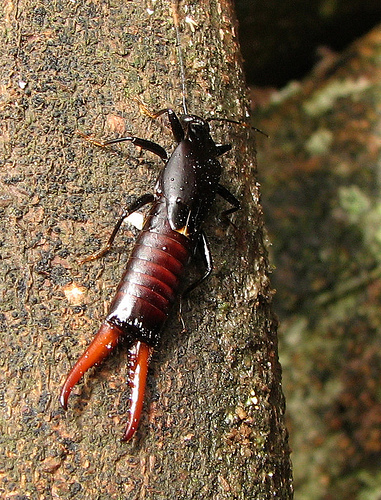Earwigs Only Look Scary!
By Chris Williams on June 9, 2014.
Earwigs are those insects with the ominous-looking pincers on their rear end. They are outdoor insects that sometimes end up inside. Despite their appearance, earwigs are relatively harmless and are considered to be occasional nuisance pests.
are those insects with the ominous-looking pincers on their rear end. They are outdoor insects that sometimes end up inside. Despite their appearance, earwigs are relatively harmless and are considered to be occasional nuisance pests.
18 Earwig Facts
- The species that most commonly infest homes are the European earwig (an introduced species about ½-inch long), the ringlegged earwig (often found in greenhouses), and the striped earwig (a large, 1-inch long species often a problem in new developments).
- The pincers (cerci) on the rear of the body are used to defend the nest, probe crevices, etc. Earwigs “pinch” rarely and only when provoked.
- In defense, some earwigs can “shoot” an odorous fluid 3 to 4 inches from their abdomen.
- Contrary to superstition (and their name), earwigs don’t crawl into the ear of a sleeping person and bore into the brain.
- In most species, the cerci are straight-sided on the female earwig and curved on the male.
- Some earwigs have wings but most are not good fliers. To fly, they must glide from a high point.
- Indoors, earwigs hide during the day in cracks and crevices and are active mostly at night. They’re attracted to lights.
- Outdoors, earwigs are found in damp areas around building foundations such as under mulch, stones, boards, etc.
- Most earwigs are scavengers and feed on decaying plant material. Some are predators, feeding on snails and insects, and some chew holes in plants.
- Some species of earwigs are secondary hosts for flatworms and poultry parasites.
- The female earwig guards and cares for her eggs and newly-hatched young in an underground nest until they are able to fend for themselves.
- Earwigs can burrow 6 feet underground to escape freezing temperatures.
- Earwigs seem to be more abundant in years with wet spring weather.
- Earwigs need moisture and may migrate indoors during dry, hot periods.
- Earwigs also hitchhike into homes on plants, newspapers, or firewood.
- Earwigs don’t survive long in the drier indoor air of homes and buildings.
- Moving mulch, leaf debris, and stacked wood or stones around your home’s foundation will remove hiding places for earwigs.
- Sealing gaps around doors and windows and having a pesticide treatment around the outside perimeter of your home will help keep earwigs out.
Photo credit: wildxplorer / Foter / Creative Commons Attribution 2.0 Generic (CC BY 2.0)